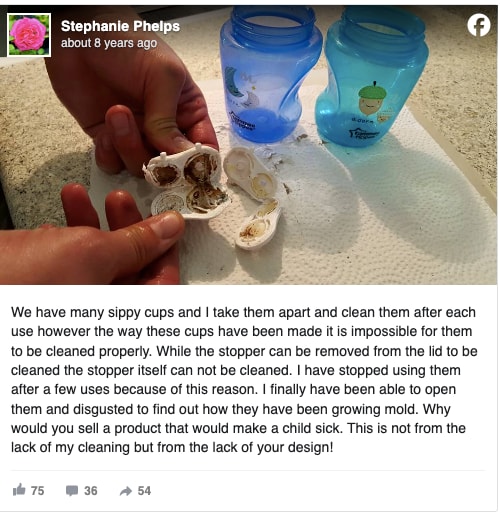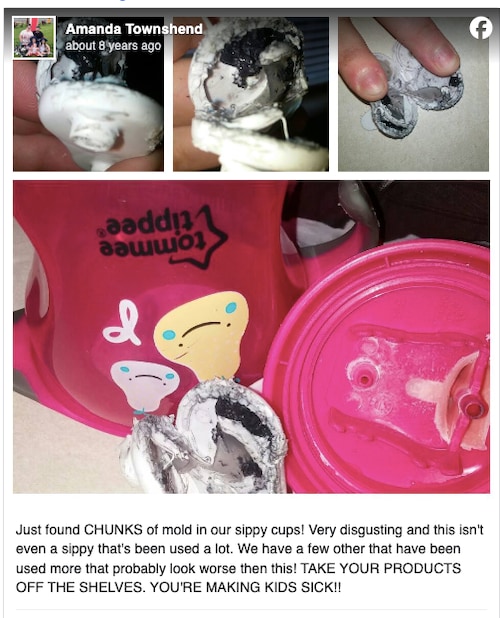It can happen to the most meticulous of parents. You take apart your child’s sippy cup or water bottle with the straw to wash it, or squeeze the excess bathwater from their rubber duckie — and staring back at you is that undeniable black gunk: mold. While the thought of mold growing inside your child’s cup or bath toys is, well, gross, try not to get too down on yourself, because it sneaks up on good parents everywhere.
In 2016, parents of young kids were (understandably) taken aback when two moms posted photos of mold in Tommee Tippee sippy cup valves on Facebook.


And this wasn’t the first time a mold scandal rocked the parenting community either: A year prior, mold was found in GoGo Squeez Applesauce Pouches, and in 2018, an Indiana dad found mold in his child’s Capri Sun.
So mold happens, but is this common fungus dangerous to your little one? Here’s what the experts have to say about mold in your child’s toys and sippy cups.
Why does mold grow in sippy cups?
Sippy cups are pretty much a dream locale for the fungus, says Dr. Sara Siddiqui, a pediatrician and clinical assistant professor in the Department of Pediatrics at NYU Langone’s Hassenfeld Children’s Hospital in New York.
According to Zahir Sardar, Pharm.D., specialist in poison information at the Poison Control Center at Children’s Hospital of Philadelphia, the reason mold often crops up in kids’ cups is because the conditions are just right.
“Mold craves warmth and moisture — and when you add food particles to the mix, mold will find your child’s sippy cup irresistible,” Sardar says.
Additionally, the parts of sippy cups, which are notoriously difficult to clean, make these products even more attractive to mold.
“Mold grows very easily in small, hard-to-reach crevices that can be warm and moist for long periods of time,” says Siddiqui.
Can mold grow in bath toys and other kid products?
While sippy cups and the ubiquitous reusable water bottles with straws may be the great love of mold’s life, they aren’t the fungus’ only suitor.
“Any product that frequently comes into contact with water or is routinely in a moist area is very susceptible to mold growth,” says Siddiqui. “And there’s even more of a chance of mold for items that have small holes or openings that are difficult to clean with soap and water — such as bath toys and sponges.” (Looking at you, rubber duckies.)
If you’re unsure if a product of your child’s is susceptible to growing mold, Sardar recommends asking yourself the following two questions: Is this product good at holding onto moisture? Are there cracks or pores that saliva or food can get trapped in?
“If the answer is yes to either of these questions, chances are that a product will be a little more susceptible to mold growth,” he says. “Common examples are water expanding toys, stress balls, bath toys, sippy cups and water bottles.”
How dangerous is this mold?
While unsightly, the danger that mold in bath toys and sippy cups poses is relatively low.
“Mold itself is not considered dangerous to a healthy individual but can cause medical issues in someone who may be allergic,” says Siddiqui. “Symptoms such as congestion, sneezing, coughing and sometimes respiratory difficulties such as asthma may happen in people of the latter category. Children that are immunocompromised or have a weakened immune system due to medication or underlying medical conditions may be more sensitive to symptoms due to mold.”
If you find mold on your child’s toy or on their bath sponge, remember there’s a good chance they didn’t ingest it — in which case, there’s nothing to worry about. And even if they did (i.e. they swallowed some bath water), in most cases, it was likely a small amount and won’t do any harm. In rare cases, kids who are sensitive to mold may experience vomiting, upset stomach or diarrhea after ingestion, according to Cincinnati Children’s Hospital.
“Mold is all around us, and we breathe in and swallow some mold every day,” Sardar says. “The type of mold, the length of time someone was exposed to mold, how they were exposed to mold and an individual’s own medical history makes each case of mold exposure unique. However, it makes sense to keep exposure to mold as low as we can reasonably manage.”
What should I do if I think my child ingested mold?
If your child is experiencing abdominal pain, nausea or vomiting after you discover mold in their sippy cup, Siddiqui suggests checking in with their doctor.
“It’s also advisable to check for allergies to mold with your doctor or allergist if you’ve found mold in your home,” she says.
One thing parents shouldn’t do when they think their child ingested mold? Induce vomiting.
“It’s very important parents don’t make their child throw up,” Sardar says. “It’s an antiquated practice that can hurt your child’s throat.”
How do you avoid mold and clean sippy cups, bath toys, etc.?
According to Siddiqui and Sardar, here are the best ways to keep mold in sippy cups and toys at bay:
- Store sippy cups in cool, dry areas.
- Leave sippy cups unassembled right after drying, which can help any remaining unseen moisture dry.
- Avoid prolonged use of sippy cups that are difficult to clean, especially in the small areas within the cup. “Replace sippy cups frequently, if possible,” says Siddiqui.
- Wash bath toys frequently and leave them to dry in a well-ventilated area.
- Wash sippy cups right after your child is done with their drink. “Leaving food particles in the cup will encourage mold growth and make cleaning more difficult later,” says Sardar.
- Visually inspect sippy cups for mold prior to each use, especially the areas that are more prone to mold growth.
- For cups that are dishwasher safe, use heat sterilization, which is a good method of killing off existing mold.




